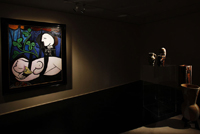 Collectors and Auctioneers See Signs that Art Market is on the Verge of Solid Recovery
Collectors and Auctioneers See Signs that Art Market is on the Verge of Solid RecoveryPablo Picasso's 1932 'Nude, Green Leaves, and Bust' is seen at Christie's auction house in New York April 16, 2010. The art market plummeted with the onset of the global financial crisis but experts, fund managers, collectors and auctioneers are rallying on signs the once-hot investment is on the verge of solid recovery. REUTERS/Shannon Stapleton.
NEW YORK (REUTERS).- The art market plummeted with the onset of the global financial crisis but experts, fund managers, collectors and auctioneers are rallying on signs the once-hot investment is on the verge of solid recovery.
Less than two years after an unusually long-lived art boom came to an end with lower prices and a decreased supply, bidders have returned to salesrooms, prices are mostly ticking up and records are being set once again.
Independent fund manager Castlestone Management, which specializes in alternative assets for global clients, has said it anticipates a 40 percent rise in art prices over the next two years.
Citing a 70 percent rise in equities prices since late 2008, Castlestone noted that "equity is considered to be a key indicator when analyzing trends in the art markets."
It compared the market to gold, which has appreciated 50 percent since November 2008 and which, like art, "is an unleveraged, irreplaceable real asset which investors turn to" during unsteady economic times.
Strong results at February's impressionist, modern and contemporary sales in London, where Swiss sculptor Alberto Giacometti's "Walking Man, I" set the record for any work sold at auction with a $104.3 million price tag, seem to bear out the optimism.
More recently, the Hong Kong sales set records and exceeded estimates, driven in part by flush Asian buyers.
In the art world, solid results boost confidence, encouraging owners of top-quality works to re-enter the market. The availability of rare or fresh-to-the-market pieces stokes bidding, which drives up prices, and a cycle is born.
Conversely, when sellers hold back, mid-range, often second-rate works tend to flood the market, drawing scant interest and tepid bidding -- if any. The result was the alarming drop-off in 2008 and 2009.
But as far back as December, Wedbush Securities upgraded Sotheby's, whose shares had been taking a beating, to outperform from neutral, citing a rebound in demand for collectible art. Sotheby's exceeded analysts' expectations with a 31 percent increase in fourth-quarter revenue.
Optimism seems well-founded with prestigious, world-renowned and hugely valuable collections hitting the block in New York in May.
"You're going to see some great prices in New York," said Philip Hoffman, founder and chief executive officer of The Fine Art Group Fund, an art investment house.
"The rare pieces are going to go through the roof and make prices that you wouldn't expect to see in the economic climate we're in," he told Reuters in a telephone interview.
Asian, Russian, Middle Eastern Buyers
But not everyone is quite so bullish.
In its first-quarter report for 2010, the Mei Moses Art Index, which tracks the value of marketable artworks, found a nearly 5 percent decrease in the return of its index.
Michael Moses, co-founder of both Beautiful Asset Advisors LLC and the index, noted this was driven by a sharp drop in a single category -- pre-1950 American collecting. All other categories had positive performance in the first quarter, led by post-war and Old Masters, the report said.
Moses also saw signs of the start of recovery, noting that "the second half of 2009 saw a repairing of world wealth," and adding "there is more of a world market for art these days than ever."
Hoffman agreed, saying Chinese collectors "are going to make a significant impact on the contemporary and impressionist market."
He also said he expected that "as oil prices get stronger it will free up lots of cash," boosting the Middle Eastern market in coming years. The Russian market was more unpredictable, he said, but added that collectors have done their homework and become more confident since first entering the market relatively uninformed several years ago.
Marc Porter, president of Christie's Americas, also looked to Asian collectors for increased presence in the salesroom.
"We expect very heavy representation at both of the evening sales (impressionist/modern and contemporary) from these regions," he said, referring to China, Russia and the Middle East.
Christie's landed the season's two big commissions, the Michael Crichton and Brody collections, which Porter expects will mirror last year's success of the Yves St. Laurent sale in Paris. "It's become a very, very active market again," he said.
According to Hoffman, the works at the very top of the price list are poised to achieve the strongest results, as much as 50 percent or more than their pre-sale estimates.
Works at the lower end of the market will probably hold their ground, he said, while those in the middle-range or by second-rate artists could actually tick down by about 20 percent.
(Editing by Michelle Nichols and Mohammad Zargham)
Art Market | Castlestone Management | Philip Hoffman | The Fine Art Group Fund |
 Collectors and Auctioneers See Signs that Art Market is on the Verge of Solid Recovery
Collectors and Auctioneers See Signs that Art Market is on the Verge of Solid Recovery